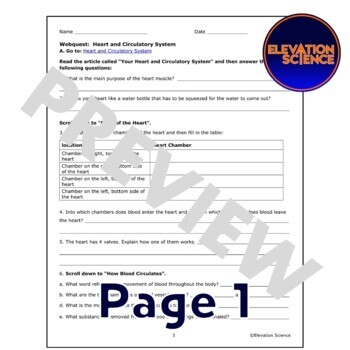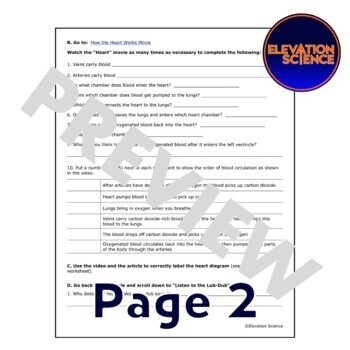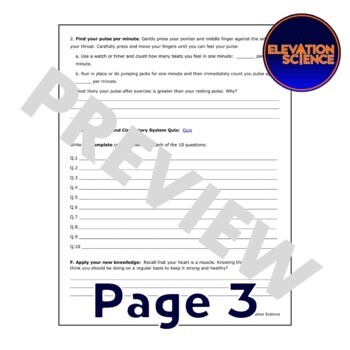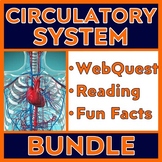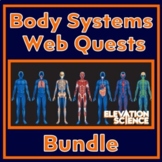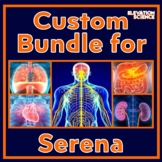Human Body Systems Heart and Circulatory System Activity Webquest
Elevation Science
638 Followers
Resource Type
Standards
CCSSRST.6-8.4
CCSSRST.6-8.7
NGSSMS-LS1-3
Formats Included
- PDF
- Google Apps™
- Webquests
Pages
3 pages
Elevation Science
638 Followers

Includes Google Apps™
The Teacher-Author indicated this resource includes assets from Google Workspace (e.g. docs, slides, etc.).
What educators are saying
This web-quest was excellent for my 9th grade Health class. It was very easily accessible for my students, they were engaged the entire time, and truly LEARNED a lot! Thank you!
This was perfect for when I had to leave in a hurry, yet wanted to have something meaningful for my students to continue learning about the circulatory system.
Also included in
- Save 30%!!! Includes three fun and informative activities for the circulatory system.This money-saving bundle includes:Web Quest: Students use the internet to access fun websites to research and answer questions on the Circulatory System.Informational Text: Students will read an article about the fuPrice $7.35Original Price $10.50Save $3.15
- SAVE MORE THAN 40% on 23 NO PREP human body systems activities, including WebQuests, fun facts readings, and informational texts! Body Systems Included:Skeletal System, Digestive System, Circulatory System, Immune System, Respiratory System, Muscular System*, Nervous System, and Excretory System. EaPrice $49.99Original Price $84.19Save $34.20
- SAVE MORE THAN 30% OFF LIST PRICES! ALL 7 WEBQUESTS INCLUDE GOOGLE DOCS AND PDF VERSIONS. Use these organ system webquests cover the basics of seven major human body systems. Each worksheet provides a structured format for students to get the most from the articles, videos, and quizzes provided bPrice $18.99Original Price $28.19Save $9.20
- This is a custom bundle for Serena.Please consider clicking HERE to follow Elevation Science on TPT!Price $33.60Original Price $48.00Save $14.40
Description
GOOGLE DOCS AND PRINT VERSION INCLUDED! This circulatory system worksheet covers the basics of how the heart brings oxygen and nutrients to all cells in the body. The worksheet provides a structured format for students to get the most from the articles, videos, and quizzes provided by www.KidsHealth.org.
This WebQuest has Several Sections:
- Part A – Review the main purpose of the heart and its physical structure.
- Part B – Watch a brief video to understand how the heart and lungs work together to bring oxygen to cells and carbon dioxide away from cells.
- Part C – Record your pulse at rest and after a brief exercise.
- Part D – Take the circulatory system quiz.
- Part E – Apply your new knowledge.
You may also be interested in our Circulatory BUNDLE!
Teacher Notes:
- This resource is not editable.
- A link to the Google Docs version is provided in the downloadable PDF.
- Includes answer key.
- Get this resource at a discount in our Body Systems WebQuest Bundle!
Please consider clicking HERE to follow Elevation Science on TPT!
Total Pages
3 pages
Answer Key
Included
Teaching Duration
N/A
Report this resource to TPT
Reported resources will be reviewed by our team. Report this resource to let us know if this resource violates TPT’s content guidelines.
Standards
to see state-specific standards (only available in the US).
CCSSRST.6-8.4
Determine the meaning of symbols, key terms, and other domain-specific words and phrases as they are used in a specific scientific or technical context relevant to grades 6–8 texts and topics.
CCSSRST.6-8.7
Integrate quantitative or technical information expressed in words in a text with a version of that information expressed visually (e.g., in a flowchart, diagram, model, graph, or table).
NGSSMS-LS1-3
Use argument supported by evidence for how the body is a system of interacting subsystems composed of groups of cells. Emphasis is on the conceptual understanding that cells form tissues and tissues form organs specialized for particular body functions. Examples could include the interaction of subsystems within a system and the normal functioning of those systems. Assessment does not include the mechanism of one body system independent of others. Assessment is limited to the circulatory, excretory, digestive, respiratory, muscular, and nervous systems.


